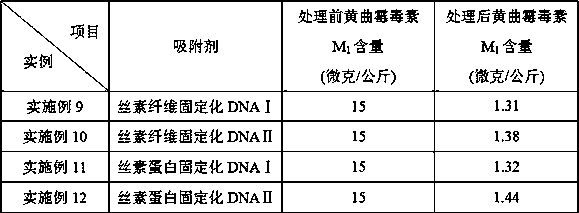Preparation method of fibroin-immobilized DNA adsorbent based on glutaraldehyde crosslinking action and application thereof in aflatoxin elimination
A technology of glutaraldehyde cross-linking and aflatoxin, applied in chemical instruments and methods, applications, dairy products, etc., can solve the problem of lack of strength, hardness, toughness, plasticity, inability to build wear-resistant, pressure-resistant, impact-resistant, Fatigue resistance, resistance to bending parts or appliances, DNA practical application limitations and other issues, to achieve the effect of good mechanical properties
- Summary
- Abstract
- Description
- Claims
- Application Information
AI Technical Summary
Problems solved by technology
Method used
Image
Examples
Embodiment 1
[0022] Embodiment 1: Preparation of silk fiber immobilized DNA I.
[0023] According to the ratio of 0.8:10 in the mass ratio of natural DNA to silk fiber, natural DNA and silk fiber are added to a phosphate buffer containing 0.25 wt% glutaraldehyde and the pH is 6-8 (the amount of phosphate buffer It is advisable to completely soak natural DNA and silk fiber), mix thoroughly, and react at 25°C for 1 hour. Rinse repeatedly with distilled water after the reaction, and keep the natural fiber in a dispersed state without agglomeration, that is, the silk fiber immobilized DNA Ⅰ, dry it for use, or soak a certain amount of silk fiber immobilized DNA Ⅰ in the buffer solution , short-term refrigerated for later use. The actual DNA content in the prepared dried silk fibroin-immobilized DNA I was 4.5%. The DNA content was determined according to the PicoGreen fluorescent dye method.
Embodiment 2
[0024] Embodiment 2: Preparation of silk fiber immobilized DNA II.
[0025] According to the ratio of 0.5:10 in the mass ratio of natural DNA to silk fiber, add natural DNA and silk fiber to a phosphate buffer solution containing 0.50wt% glutaraldehyde and a pH of 6-8, mix well, and The reaction was carried out at 25°C for 1 hour. Rinse repeatedly with distilled water after the reaction, and maintain the dispersed state of the natural fibers without agglomeration, that is, the silk fibers are immobilized with DNA II and dried for later use, or a certain amount of silk fibers with immobilized DNA II is immersed in a buffer solution , short-term refrigerated for later use. The actual DNA content in the prepared dry silk fiber immobilized DNAⅡ was 3.5%. The DNA content was determined according to the PicoGreen fluorescent dye method.
Embodiment 3
[0026] Example 3: Preparation of Silk Fibroin Immobilized DNA I.
[0027] According to the ratio of natural DNA and silk fibroin mass ratio of 0.8:10, add natural DNA and silk fibroin to a phosphate buffer solution containing 0.25wt% glutaraldehyde and a pH of 6-8, mix well, and The reaction was carried out at 25°C for 1 hour. After the reaction, add methanol (the maximum amount of methanol used is 80% of the total mass of the reaction solution) to promote the coagulation of silk fibroin into a water-insoluble silk fibroin-immobilized DNA I. Isolate the silk fibroin-immobilized DNA I, rinse it repeatedly with distilled water, dry it for use, or soak a certain amount of silk fibroin-immobilized DNA I in a buffer solution, and refrigerate it for short-term use. The actual DNA content in the dried sample was 4.7%. The DNA content was determined according to the PicoGreen fluorescent dye method.
PUM
 Login to View More
Login to View More Abstract
Description
Claims
Application Information
 Login to View More
Login to View More - R&D
- Intellectual Property
- Life Sciences
- Materials
- Tech Scout
- Unparalleled Data Quality
- Higher Quality Content
- 60% Fewer Hallucinations
Browse by: Latest US Patents, China's latest patents, Technical Efficacy Thesaurus, Application Domain, Technology Topic, Popular Technical Reports.
© 2025 PatSnap. All rights reserved.Legal|Privacy policy|Modern Slavery Act Transparency Statement|Sitemap|About US| Contact US: help@patsnap.com


